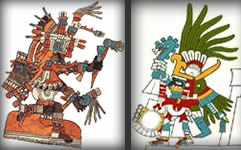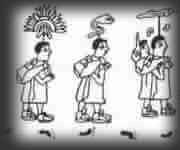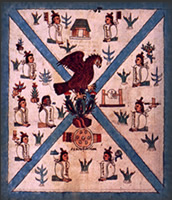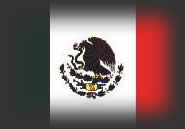![]()

![]()
“Huitzilopochtli
commands us to look for this place. When we discover it
we shall be fortunate, for there we shall find our rest, our
comfort and our grandeur...”
Historia
de la Indias de la Nueva España, Fray Diego Duran, 1581
The earliest Aztecs—or Mexica—did not keep written records, passing on their traditions by word of mouth from one generation to the next until the 16th century when Spanish friars wrote down much of their history. In addition, the story of their migration from the legendary northern homeland of Aztlán (‘place of the heron’) under the guidance of the god Huitzilopochti (above right) appears in several post-conquest works that use the traditional Toltec writing that is both pictographic and ideographic. For instance the Boturini codex (below): here Huitzilopochtli is shown wrapped in a medicine bundle, and carried on the back of one of the priests. (The image depicts, with ‘speech glyphs’, the god giving directions; the ‘footprints’ in the codex, often believed to indicate direction, have also been interpreted as an indication of the god’s invisible presence.)

Codex Boturini
(the
priest in the lead is depicted carrying the image of the god)

The divine ‘sign’
from Codex Mendoza

Image of the eagle
and the serpent
on the Mexican flag
According to tradition, Huitzilopochtli told the Mexica to search for a sign—an eagle perched on a cactus devouring a snake—an epiphany that they subsequently observed on an island in Lake Texcoco. The humble settlement subsequently established there grew into Tenochtitlan (‘place of the fruit of the cactus, tenochtli’)—now Mexico City. It was after their rise to power that the Aztecs declared Huitzilopochtli to be the supreme god of war and their own particular patron.
In 1519 CE* the Spanish conquistador Hernando Cortes landed on the Mexican coast, thus initiating an encounter that would be entered into history—on both sides—in frankly mythic terms. Bernal Diaz, one of the soldiers accompanying Cortes, describes his first impressions of the great Aztec empire: “And when we saw all those cities and villages built in the water, and other great towns on dry land, and that straight and level causeway leading to Mexico [i.e. Tenochtitlan], we were astounded...[It] seemed like an enchanted vision from the tale of Amadis. Indeed some of our soldiers asked whether it was not all a dream...It was all so wonderful that I do not know how to describe this first glimpse of things never heard of, seen or dreamed of before.” (The Conquest of New Spain, c1570 CE.)
A people’s beliefs can condition both perception and expectation. By an astounding coincidence, Cortes had landed in Mexico on the day in the Aztec sacred calendar prophesied for the return of another native deity, the god Quetzalcoatl. When the Mexica ruler, Moctezuma Xocoyotzin, finally met Cortes on the outskirts of Tenochtitlan, he is quoted as saying: “Thou hast come to arrive on earth. Thou hast come to govern the city of Mexico; thou hast come to descend on my mat...which I have guarded for thee...” (Historia general de las cosas de Nueva España, Bernardino de Sahagun).
The Aztecs had been aware of the presence of the Spanish almost from the moment they had beached their ships, and apprehension and apocalyptic fervour was rife. Moctezuma himself was prone to experiencing visions, and it seems certain that he believed—at least initially—that he was walking out to an encounter with the divine. At the same time, from Bernal Diaz’s account of events it is clear that the Spanish interpreted much of what happened (not to mention justifying the conquest itself) in terms of their own Christian doctrine and beliefs.
Just ten years after the conquest of Tenochtitlan, an Aztec baptised by Spanish friars had a vision of Mary, the mother of Jesus; this ‘Virgin of Guadalupe’ demanded that a church be built for her on Tepeyac Hill. It is perhaps no small coincidence that the church was established on the very spot previously occupied by a temple dedicated to the earth goddess Tonatzin; nor that the bishop who was instructed to ensure the construction was the same man who had previously given the order to have Tonatzin’s temple razed.
In the centuries following the conquest, several people have tried to identify the god Quetzalcoatl with Christ, seeing in the conversion of the natives the ‘proof’ of his return. The Spanish may have imposed their religion on the subjugated people, however willing their conversion. But a people’s sacred history is not easily relinquished; the sign given to the Aztecs during their wanderings—the eagle devouring the serpent—now appears in the centre of the Mexican flag.
*CE, Common Era. Used in place of AD, Anno Domini, which is Latin for ‘[in the] year of [Our] Lord’